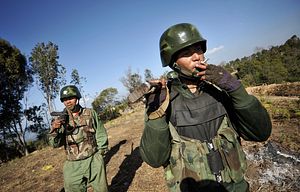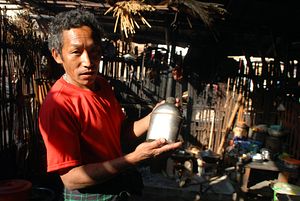“The water stays cool inside even if the bottle sits in the sun for the whole day.” Tu Ja proudly explains the virtue of storing water in his 1943 U.S. Army stainless steel flask, one of the few belongings he could save when fleeing his village from the advancing Myanmar army in 2011. The internally displaced person (IDP) holds the bottle against a sun beam entering the dim communal cooking space in one of the countless makeshift camps in Kachin State. The smoke from open fires in the cramped space makes it hard to breath. Yet, Tu Ja goes on telling the story of a water bottle which seems to be as displaced as himself in this remote corner of northern Myanmar. It was given to him by his grandfather who fought with the Kachin Rangers for Detachment 101 of the American Office of Strategic Services against the Japanese on one of the Second World War’s most vicious battlefields. The Kachin, an ethnic minority group, have earned a reputation for being skilled mountaineers without whose courageous and fierce fighting abilities the Allied forces could not have driven the Japanese out of Burma. U.S. soldiers have long left these rugged borderlands in between Myanmar and China. Sadly, war has stayed.
For many decades this area has witnessed various ethnic armed groups struggling for minority rights and political autonomy against central government control. After the breakdown of a 17-year long ceasefire in 2011, conflict escalated again between Naypyidaw and the Kachin Independence Organisation (KIO). Since then, large-scale army offensives against rebel-held positions have displaced more than 100,000 civilians. While this conflict is largely ignored by the international media, international affairs are closely followed in the tea houses of Laiza, a small town nestled on the border of China’s Yunnan province and headquarter of the KIO. “One of our long-term mistakes was to think that we can be allies of the U.S.,” an officer of the 10,000 man-strong Kachin Independence Army (KIA) – the armed wing of the KIO – explains over dinner. “You know, we helped the Americans in the past and we identify with them. After all they brought us Enlightenment: our script and the Bible,” he continues by referring to the Swedish-American missionary Ola Hanson, who spread the gospel in Myanmar’s borderlands and developed an orthography for the Kachin language in the late 19th century.
After some more sticky rice wine, the officer points into the direction of China: “Today we understand that only our big neighbor can save us. We should not have focused on the U.S. so much.” The KIO has indeed long tried to build good relations with the United States. At a time when most other ethnic armed groups in Myanmar’s northern borderlands fought under the umbrella of the Chinese-backed Communist Party Of Burma (CPB), the KIO chose a different path. Despite its geographical proximity to China, it aligned with the National Democratic Front (NDF), Myanmar’s other important ethnic armed resistance coalition that emerged during the Cold War. This pro-Western alliance comprised mainly ethnic rebel movements along the Thai border, most prominently the Karen National Union (KNU), the principal beneficiary of weapons and money from anti-communist Thailand at the time. This choice has placed the KIO in a difficult position. It alienated the Chinese next door, while U.S. support never materialized.
After the KIO signed a ceasefire with the Myanmar government in 1994, its relations with China significantly improved. This has particularly owed to the ever increasing importance of border trade, which is instrumental for the development of China’s land-locked Yunnan province. Trade with Myanmar – including with and by way of KIO controlled territories – accounts for more than three quarters of Yunnan’s total border trade. Recent Chinese investments in strategic infrastructure affecting rebel-controlled areas – such as large hydropower dams as well as gas and oil pipelines – have further increased the need to come to terms with each other. Yunnan’s provincial authorities have hence developed a good working relationship with various ethnic armed groups along their border with Myanmar. Beijing has, however, remained more careful. China’s central policymakers are particularly cautious about alienating Naypyidaw, with which they have developed an intimate relationship ever since the West isolated Myanmar’s military rulers with strict sanctions after their brutal crackdown on Yangon’s pro-democracy movement in 1988.
Since the escalation of the conflict in Kachin State, Beijing has pressured the KIO to accede to Naypyidaw’s demands for another ceasefire on worse terms than before. With rapidly improving relations between the West and Myanmar, however, the Chinese posture has begun to change. “The Chinese have started to make our lives easier. Since the end of last year we can travel more freely on the Chinese side, and the Chinese Red Cross finally began to support some of the IDP camps in our area,” the KIA officer explains, while dissecting some barbecued fish with his chopsticks. He leaves no doubt about the rationale behind this: “You know, the U.S. wants to encircle China by improving their relations with the Tatmadaw [the Myanmar army]. So China uses us as a stick to punish Myanmar because it is getting too close to America. The friendlier Washington and Naypyidaw become, the nicer China treats us. This is a big power game.” Given the recent honeymoon between Myanmar and the United States, the analysis seems hard to fault.
Relations between Myanmar and the U.S. have seen remarkable rapprochement since the start of the former’s reform process. Despite the doubts of many observers about the sincerity of reforms – particularly whether the former junta handed over actual power to the civilian government – the administration of U.S. President Barack Obama has lifted most sanctions with exceptional alacrity. Still, U.S. firms remain cautious about investing in Southeast Asia’s “last frontier economy.” They complain about the lack of infrastructure, inadequate investment laws, an unskilled labor force, and government restrictions. This lack of enthusiasm is in stark contrast with the situation in, say, Iran, where business interests lobby for the lifting of sanctions. The geostrategic stand-off with China is, in fact, the best explanation for Washington’s foreign policy shift towards Myanmar. While Obama’s recent attempt to reestablish military ties with the Tatmadaw could not overcome congressional resistance, the Kachin understood the wink. After taking a deep drag of his Yunnanese cigarette the KIA officer concludes: “We are really careful to invite U.S. observers to peace talks because the Chinese are not happy about Americans meddling in their backyard. As the U.S. is only interested in Naypyidaw, we should invest in good relations with China now.”
His analysis demonstrates why Washington’s current Myanmar policy will actually not work to curtail China in the long-run. It may even play into Chinese hands. In view of Naypyidaw’s close ties with and dependence on China, Washington cannot hope for any significant U.S.-Myanmar alliance against China in the near future. Moreover, observers agree that any sustainable political settlement and the future of reforms in Myanmar will be contingent on some form of power sharing with the country’s ethnic minority groups. Taken together they actually represent up to 40 percent of the country’s overall population of 60 million. Obama’s hasty appraisal of Naypyidaw’s reforms and simultaneous ignorance of political grievances and humanitarian suffering in the country’s borderlands threatens to drive this significant part of Myanmar’s populace closer to China. If Washington does not reconsider this approach – and a visit to the U.S. by General Gun Maw of the Kachin Independence Army has urged it to become more involved in peace efforts – then the proud feelings of affiliation with America among ethnic minorities in Myanmar will quickly fade together with U.S. Army steel flasks in the country’s IDP camps. In the end, Beijing will laugh twice.
David Brenner is a PhD candidate in International Relations at the London School of Economics and Political Science. His thesis traces the effects of transforming border economies on armed conflict in Myanmar/Burma, specifically examining their impacts on the internal politics of armed groups and their negotiations with the government.


































